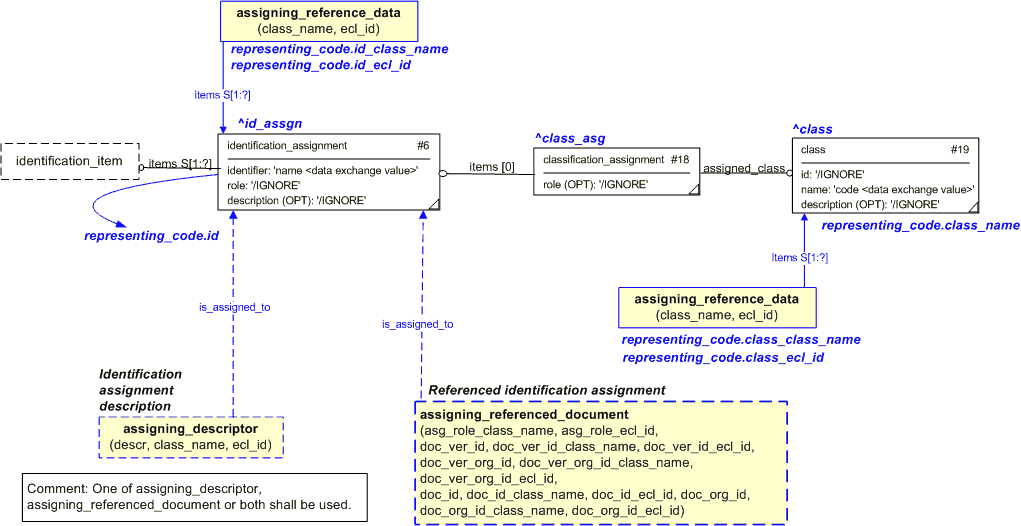Template:— representing_code (rep_code)
Context:— NDLO |
Date: 2008/02/21 16:26:54
Revision: 1.3
|
This section specifies the template representing_code.
NOTE
The template has been defined in the context of
NDLO.
Refer to the business context for details of related templates.
NOTE
An explanation of a template and the associated instantiation path is
provided in the
Template overview
section.
This template describes how to represent a code with its encoding system. An instance of identification_assignment should
have an instance of document_assignment classified as "Encoding system" assigned to it. The encoding system is specified by either identification assignment description (template assigning_descriptor), referenced
identification assignment (template assigning_referenced_document) or both.
The EXPRESS-G diagram in
Figure
1
shows the templates and EXPRESS entities that are required
to represent the template
"representing_code".
The text highlighted in blue shows the template parameters.
...
Figure 1 — An EXPRESS-G representation of the Information model for representing_code
The graphic for the template to be used in other EXPRESS-G diagrams
is shown in Figure
2
below.
...
Figure 2 — The graphical representation of the representing_code template
The following input parameters are defined for this template:
The identifier being assigned. In this case the specifying the name of the code, e.g. Critical. If there
is no value for the identifier the value should be set to "class_name"+"."+"class_class_name".
The name of the class used to classify the identifier and so provide the role or reason for the identification.
In this case the class should carry the same prefix than the class used to classify the value of the code, e.g. Safety_name.
The following classes and their sub-classes can be used:
id_ecl_id (Default=urn:plcs:rdl:std,Type='URN')
The class_name represents the value of the code, e.g. "3".
The name of the class used to classify the identifier and so provide the role or reason for the identification.
In this case the class specifies the type of code, e.g. Safety_code.
The following classes and their sub-classes can be used:
The items to which the identification is assigned
The following reference parameters are defined for this template:
%^target = $representing_code.id_assgn%
Allow the
Class
entity instantiated in this path to be referenced when this template is used.
Note: The
Class
entity can be referenced in a template path by:
%^target = $representing_code.class%
where
target
is the parameter to which the
Class
is bound.
%^target = $representing_code.class_asg%
The instantiation path shown below specifies the entities that are to be
instantiated by the template.
A description of templates and the syntax for the instantiation path is
provided in the
Templates Help/Information section.
The following entities are instantiated with attributes as specified:
The instance diagram in Figure
3
shows an example of the EXPRESS entities and templates that are instantiated by the template:
/representing_code(items='#1', class_name='....', ecl_id='urn:plcs:rdl:std')/
(an illustration of the consolidated representing_code template is shown in
Figure
4 below.)
Figure 3 — Entities instantiated by representing_code template
The instance diagram in
Figure
4
shows the graphic symbol for the template that is to be
used in other instance diagrams. The example template is:
/representing_code(items='#1', class_name='....', ecl_id='urn:plcs:rdl:std')/
Figure 4 — Instantiation of representing_code template
The following section details how the
representing_code
template can be optionally characterized by assigning
other constructs to it. These are characterizations commonly
applied to the template. The ISO 10303-239 EXPRESS model may enable
other assignments to the entities instantiated by the template.
The following characterizations may apply:
Characterization Identification description or document reference
NOTE this characterization is optional.
The identification assignment Identification_assignment
has to have one of the optional templates assigned. Either assigning_descriptor or assigning_referenced_document
![[warning:]](../../../../../../images/dex/warning.gif) Error T1: DEX assigning_referenced_document not in Dexlib
Error T1: DEX assigning_referenced_document not in Dexlib
. The parameters for both templates are listed as part of the list of input parameters and have to be chosen respectively.





![]() Error T1: DEX assigning_referenced_document not in Dexlib
Error T1: DEX assigning_referenced_document not in Dexlib